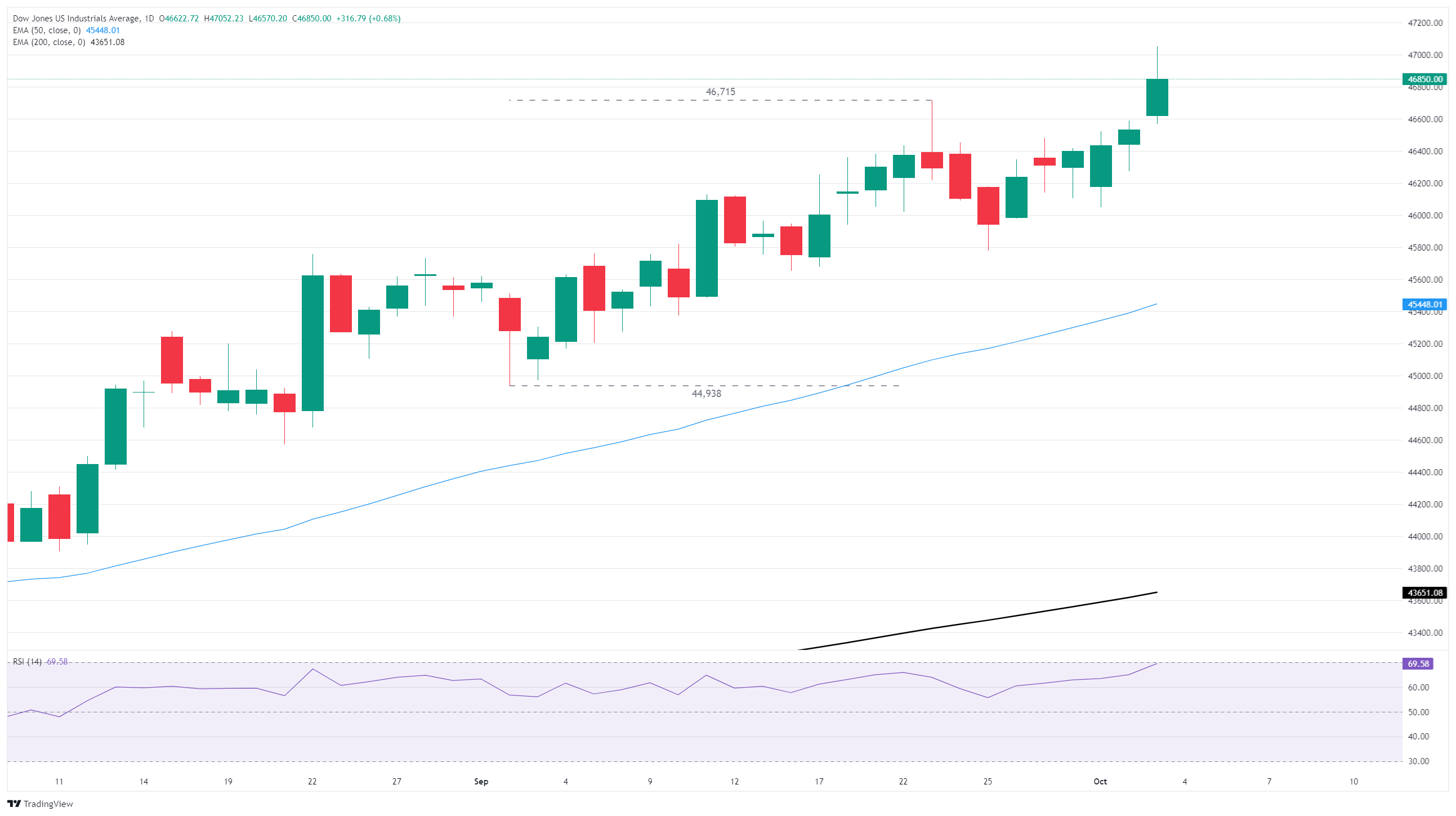Dow Jones Industrial Average rises 300 points on Friday
- The Dow Jones hit a fresh all-time high on Friday, clipping 47,000.
- Late-session profit-taking trimmed the Dow’s bullish momentum, but the index still remains firmly in the green.
- Investors are shrugging off the ongoing US government shutdown for the time being as NFP delay bolsters rate cut hopes.
The Dow Jones Industrial Average (DJIA) caught a firm bid on Friday, rising 482 points, or 1.04%, bottom-to-top. The Dow briefly pierced the 47,000 major price handle for the first time ever, before easing back to a more sedate +300 points (0.65%) on the day. Broad-market index gains were trimmed by a late-session pullback in familiar tech names such as Palantir (PLTR), Tesla (TSLA), and Nvidia (NVDA).
Equities climb despite key data going dark
The Dow has chalked up another bullish week, closing flat or in the green for a fourth consecutive trading week as bullish investor sentiment continues. Markets are shaking off the US government’s ongoing budget shutdown, with investors confident that the federal closure will be short-lived. In the meantime, the absence of key official labor data has limited the available pool of data that the Federal Reserve (Fed) can use to inform its interest rate decisions, reinforcing investor expectations that the Fed will deliver a follow-up quarter-point interest rate cut on October 29.
The Trump administration is chomping at the bit to use the federal shutdown as an opportunity to shutter and terminate entire departments of federal workers within the government, a policy move that could put further pressure on the labor market, ostensibly in a move to trim overspending at the federal level. After the DOGE experiment headed up by former Trump frontman Elon Musk failed to generate the outsized cost savings that were promised at the beginning of Donald Trump’s second term, the federal government has overspent on its budget every single month since Trump took office in January.
Lacking NFP, labor market appears to be weakening, bolstering rate cut odds
The Trump administration’s moves to further cut federal employment amidst the government shutdown bode poorly after ADP Employment Change figures posted earlier this week saw the datapoint’s steepest single-month decline in over two years. The latest Nonfarm Payrolls (NFP) report has been suspended until the government shutdown ends, and investors expect that the missing datapoint will limit the amount of data that the Fed could use to avoid further interest rate cuts through the remainder of the year.
Dow Jones daily chart

Dow Jones FAQs
The Dow Jones Industrial Average, one of the oldest stock market indices in the world, is compiled of the 30 most traded stocks in the US. The index is price-weighted rather than weighted by capitalization. It is calculated by summing the prices of the constituent stocks and dividing them by a factor, currently 0.152. The index was founded by Charles Dow, who also founded the Wall Street Journal. In later years it has been criticized for not being broadly representative enough because it only tracks 30 conglomerates, unlike broader indices such as the S&P 500.
Many different factors drive the Dow Jones Industrial Average (DJIA). The aggregate performance of the component companies revealed in quarterly company earnings reports is the main one. US and global macroeconomic data also contributes as it impacts on investor sentiment. The level of interest rates, set by the Federal Reserve (Fed), also influences the DJIA as it affects the cost of credit, on which many corporations are heavily reliant. Therefore, inflation can be a major driver as well as other metrics which impact the Fed decisions.
Dow Theory is a method for identifying the primary trend of the stock market developed by Charles Dow. A key step is to compare the direction of the Dow Jones Industrial Average (DJIA) and the Dow Jones Transportation Average (DJTA) and only follow trends where both are moving in the same direction. Volume is a confirmatory criteria. The theory uses elements of peak and trough analysis. Dow’s theory posits three trend phases: accumulation, when smart money starts buying or selling; public participation, when the wider public joins in; and distribution, when the smart money exits.
There are a number of ways to trade the DJIA. One is to use ETFs which allow investors to trade the DJIA as a single security, rather than having to buy shares in all 30 constituent companies. A leading example is the SPDR Dow Jones Industrial Average ETF (DIA). DJIA futures contracts enable traders to speculate on the future value of the index and Options provide the right, but not the obligation, to buy or sell the index at a predetermined price in the future. Mutual funds enable investors to buy a share of a diversified portfolio of DJIA stocks thus providing exposure to the overall index.

